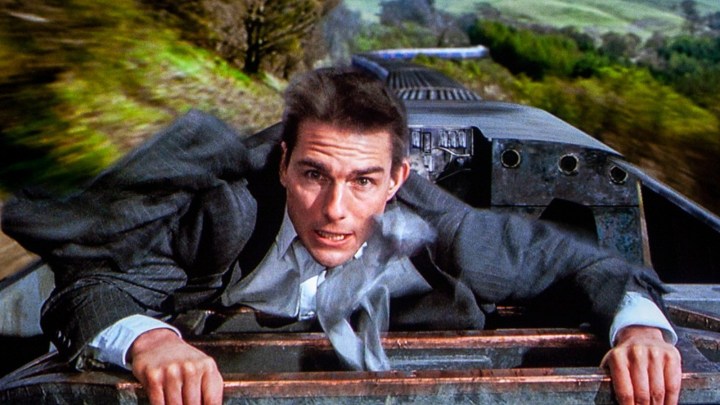
Everyone loves the Mission: Impossible movies. There are a variety of reasons why: they offer old-fashioned cinematic thrills; they are a form of escapism akin to the James Bond movies, but tougher and more American; they feature one of the last truly great movie stars, Tom Cruise. Ever since the fourth installment, Ghost Protocol, resurrected the genre from pop culture oblivion, the conventional wisdom is that the modern M: I films just keep getting better and better, and are the series’ best entries.
Well, nuts to that. I’m not going to defend the much-maligned M: I 2, which doesn’t really deserve reconsideration (seriously, what’s with all those doves?), but the original Mission: Impossible, in my eyes, is perfection, and hasn’t been topped by any other M: I film … or any action movie, for that matter. The peak of ’90s Hollywood blockbuster filmmaking, Mission: Impossible delivers two cinematic giants, Cruise and director Brian De Palma, at the height of their powers, and is perhaps the most fun mainstream movie Hollywood ever produced. Here are just a few reasons why the original M: I still holds up today.
The opening titles
How cool is the original Mission: Impossible? Even the opening titles are badass. Let’s acknowledge the big bold font which spells out all you need to know: this is a Brian De Palma movie with Tom Cruise released by Paramount Pictures. That’s it; there’s no need to know who wrote the movie or who else is in it. There’s no time for that, the titles seem to insist. Interspersed that with a lit fuse and the classic TV theme song, now updated by composer Danny Elfman and U2’s Bono and the Edge, and you get the beginning of a roller coaster ride.
But what makes the opening truly unique about that sequence is the fact that the entire movie is laid out for the audience in 10 seconds. That’s right, De Palma had the guts to feature scenes throughout the movie in the opening credits, including the revelation that Jim Phelps is alive and the villain, right there at the beginning of the movie. Of course, if you’re watching it for the first time, you can’t quite make much sense out of the mishmash images that flicker before you, but it’s only on a rewatch when you see all the pieces of the puzzle laid out by the director. It’s a ballsy move, but what else would you expect from this movie?
It killed off almost the entire cast within the first 25 minutes
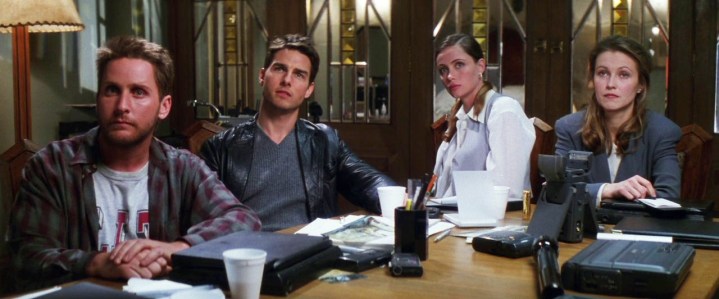
It’s 2023, and if you’re reading this article, I can assume you know what happens in the movie’s first 25 minutes: the mission in Prague is botched, almost everyone is killed, and our boy Ethan is on the run. What everyone forgets is just how shocking it was to have almost the entire Mission: Impossible team brutally and systematically murdered so quickly and so ruthlessly. Mission: Impossible was known as a team franchise at this point, so where on Earth are we going from here now that it’s just Ethan and his too-tight white A-shirt?
De Palma, always the Hitchcock acolyte, one-upped his mentor in this sequence. Hitch only managed to kill one notable actress, Janet Leigh, in the opening of one of his films, Psycho; De Palma kills five, including an Academy Award winner (Jon Voight), a rising star (Kristen Scott-Thomas was just about to break through that year in The English Patient), and perhaps the most likable member of the Brat Pack ever (Emilio Estevez, whose death still ranks as one of the goriest in the series). Several of these people come back, of course, but most don’t, and it’s this surprisingly violent prologue that sets the tone for the rest of the movie. No one is safe, and absolutely no one can be trusted.
It cast a respected British actress as the main villain
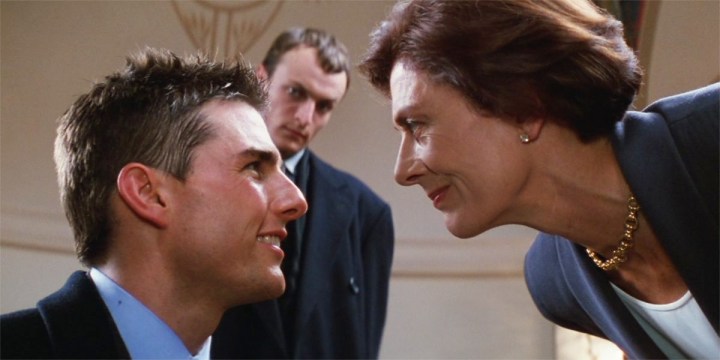
Listen, ’90s action movies were testosterone-heavy and still dominated by the Schwarzenegger/Stallone ethos of the 1980s: these movies had to be bigger, louder, and brasher than the competition. Just look at Demolition Man, True Lies, or Eraser: all macho posturing, with equally macho male antagonists to fight and kill. So it was surprising in 1996, and still a bit shocking now, that the main villain of Mission: Impossible is none other than respected stage and screen actress Vanessa Redgrave, who was pushing 60 when the first movie came out and was not at all associated with the action movie genre.
Make no mistake, Redgrave’s Max is no pushover; coy and slippery, she’s ready to kill anyone and walk away with a clean conscience. What’s so enjoyable about Redgrave’s performance is how much fun she’s having in her scenes with Cruise. She’s having a ball, and her mixture of sexiness and oily self-determination paved the way for Helen Mirren’s Magdalena Shaw in the Fast & Furious franchise and other respected actresses of a certain age working in the action genre.
Danny Elfman’s techno-infused score
It’s surprising to look at all the Mission: Impossible movies and not really remember any of their scores. The best action movies have memorable orchestral accompaniments, and the recent M:I movies just don’t have standout musical scores. Heck, even Hans Zimmer’s M:I 2 score doesn’t stand out, and Zimmer is the master of the action movie score. (Don’t believe me? Just listen to his excellent work in Crimson Tide, The Dark Knight, and about two dozen other movies).
The original Mission: Impossible, however, does have a great score, and that’s thanks to Danny Elfman, who was at the height of his powers in 1996 having just created the lush Gothic soundscapes of Batman Returns and the haunted fairy tale lands of The Nightmare Before Christmas. In M: I, Elfman utilized what was in vogue in film scoring at the time, techno music, and combined it with a classic action movie composition, creating an urgent, relentless score that was the perfect accompaniment to De Palma’s elegant and crisp visuals. Just imagine the climactic train sequence without Elfman’s music, which provides so much tension and drive to the scene. Just like his work on the two Tim Burton Batman movies, Elfman is a key player in making Mission: Impossible work as well as it does.
The heist in Langley is top-notch
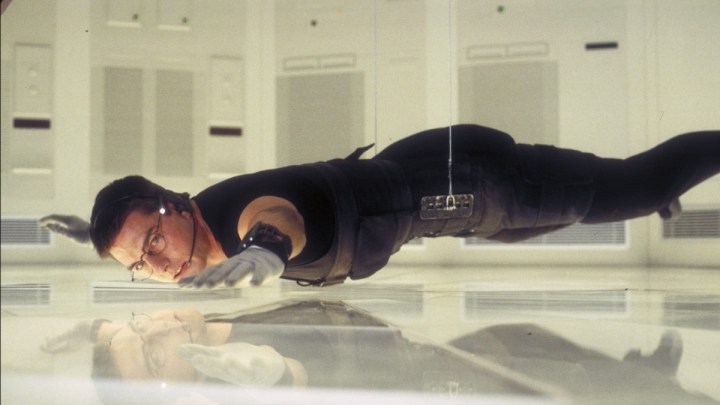
What else can be said about this rightly celebrated sequence? For those who don’t know, the scene arrives near the middle of the movie when Ethan and a new disavowed crew of IMF spies have to break into the FBI’s headquarters in Langley to steal the NOC list. What’s the NOC list? It’s complicated, but all you need to know is that it’s important and heavily secured in a heat-sensitive, noise-resistant vault that is constantly guarded by humans, computers, and maybe God itself. Absolutely no one can get in.
No one … except Ethan Hunt, of course. In a bravura, nearly silent 10-minute sequence, we get to see Ethan pull off the heist of the century through a careful arrangement of strength, balance, teamwork, and a little bit of luck. It’s this sequence that everyone remembers from the first film, and with good reason; it’s simply one of the best-directed scenes of all time.
The fight and chase sequence on the train remains the series’ best action setpiece
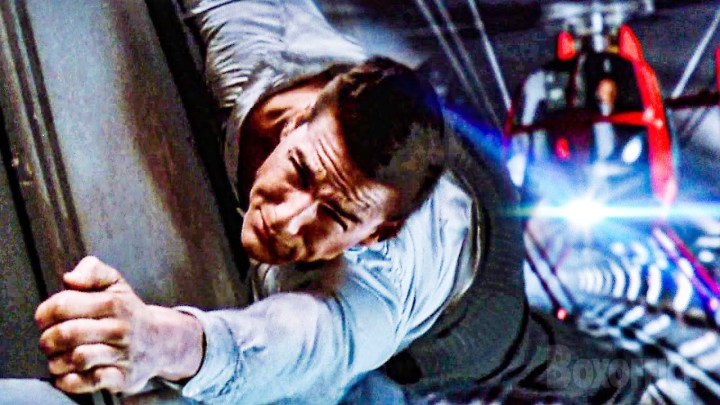
As good as the Langley heist sequence is, I’ve always enjoyed the climactic fight and chase scene on the train more simply because it’s the most insane scene in action movie history. We’ve seen fights on the top of trains before, but never on a high-speed locomotive zooming from London to Paris, with the wind battling against both Cruise’s hero and Voight’s villain. The visual effects here are truly outstanding here since they are just as effective and realistic looking in 2023 as it was in 1996. Yes, you really believe Tom Cruise is on top of a train, and you believe a helicopter piloted by French actor Jean Reno can be tied to the end of that train going 200 miles per hour. It doesn’t make sense on paper, but it makes sense on the big screen, and that’s all that matters in Mission: Impossible.
But wait, the scene just gets better as the train approaches a tunnel. While other action movies would’ve killed off Reno in the helicopter at the point, De Palma decides to have the helicopter keep chasing the train in the tunnel. What insanity is this? This shouldn’t work, but it does, through a magical mixture of De Palma’s chutzpah, Elfman’s throbbing score, and the actors all selling the green screen absurdity.
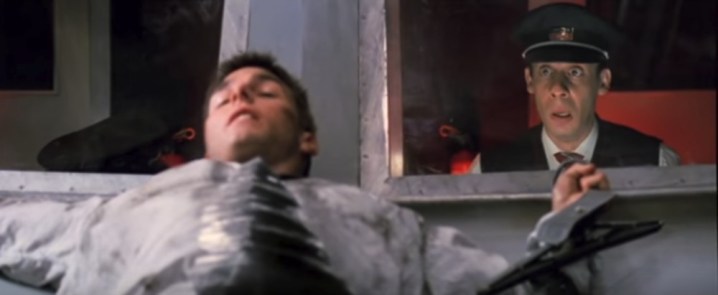
Would you believe the scene ends with Cruise using combustible gum to kill the bad guys, which results in him leaping off an exploding helicopter onto the train, and escaping the runway copter blades by mere centimeters? Of course you would, because this is Mission: Impossible, which has always combined realism and fantasy in an entertaining cocktail of blockbuster mayhem. This scene encapsulates why I love the series, and why the original Mission: Impossible still remains the best in the franchise.
Mission: Impossible – Dead Reckoning Part 1 is now playing in theaters nationwide.



